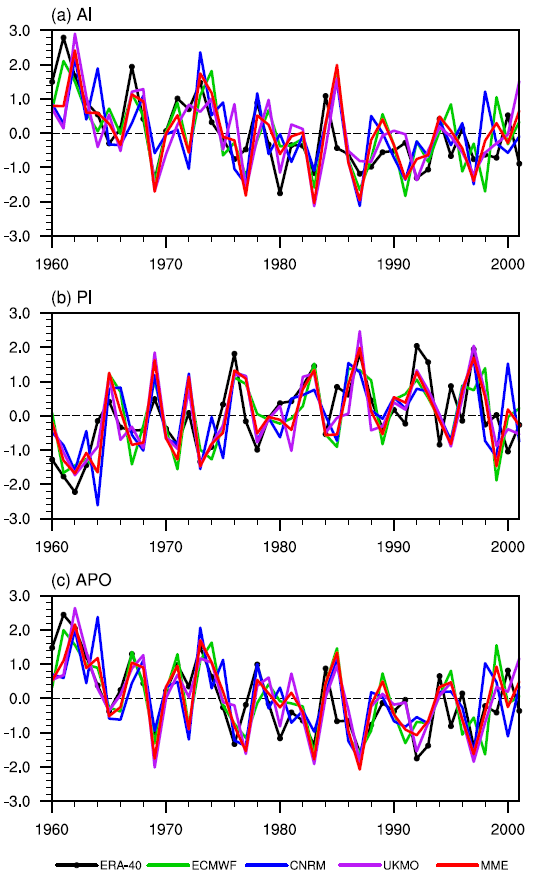
IAP Scientists Improve Asian–Pacific Oscillation Prediction
Oct 31, 2014 Email"> PrintText Size

The Asian-Pacific Oscillation (APO) is a large-scale teleconnection over the Asian-North Pacific sector and is closely associated with the summer climate over East Asia, the sea surface temperature and the tropical typhoon frequency in the western North Pacific. Considering the current limited prediction skill of the East Asian summer climate, investigating the APO prediction is meaningful.
Scientists from Institute of Atmospheric Physics (IAP) of Chinese Academy of Sciences investigated the predictability of the APO in DEMETER General Circulation Models (GCMs) and found that the GCMs are good at predicting the interannual variability of the APO and the associated circulation anomalies. However, there are substantial deficiencies for the GCMs in predicting the APO, such as the limited skills for the Asian upper-tropospheric temperature and the poor performances for the long-term varying trends.
Therefore, they used the interannual increment approach to improve the APO prediction. Treating the year-to-year increment of a variable as the predictand, the interannual increment approach produced the final predicted variable by adding the predicted DY (i.e., the difference in the variable between the current year and the previous year, called DY) of the variable to the observed value from the previous year.
The results show that this new interannual increment approach can significantly improve the APO prediction. Moreover, the improved APO predictions are further used to improve the prediction of summer rainfall over the middle and lower reaches of the Yangtze River valley.
The study has been published in Journal of Climate in 2013 and 2014.

Figure: The observed and model predicted Asian upper-tropospheric temperature AI (a), North Pacific upper-tropospheric temperature PI (b) and APO (c) using interannual increment approach. (Image by HUANG Yanyan's group)
The Asian-Pacific Oscillation (APO) is a large-scale teleconnection over the Asian-North Pacific sector and is closely associated with the summer climate over East Asia, the sea surface temperature and the tropical typhoon frequency in the western North Pacific. Considering the current limited prediction skill of the East Asian summer climate, investigating the APO prediction is meaningful.
Scientists from Institute of Atmospheric Physics (IAP) of Chinese Academy of Sciences investigated the predictability of the APO in DEMETER General Circulation Models (GCMs) and found that the GCMs are good at predicting the interannual variability of the APO and the associated circulation anomalies. However, there are substantial deficiencies for the GCMs in predicting the APO, such as the limited skills for the Asian upper-tropospheric temperature and the poor performances for the long-term varying trends.
Therefore, they used the interannual increment approach to improve the APO prediction. Treating the year-to-year increment of a variable as the predictand, the interannual increment approach produced the final predicted variable by adding the predicted DY (i.e., the difference in the variable between the current year and the previous year, called DY) of the variable to the observed value from the previous year.
The results show that this new interannual increment approach can significantly improve the APO prediction. Moreover, the improved APO predictions are further used to improve the prediction of summer rainfall over the middle and lower reaches of the Yangtze River valley.
The study has been published in Journal of Climate in 2013 and 2014.

Figure: The observed and model predicted Asian upper-tropospheric temperature AI (a), North Pacific upper-tropospheric temperature PI (b) and APO (c) using interannual increment approach. (Image by HUANG Yanyan's group)
CAS Institutes
There are 124 Institutions directly under the CAS by the end of 2012, with 104 research institutes, five universities & supporting organizations, 12 management organizations that consist of the headquarters and branches, and three other units. Moreover, there are 25 legal entities affiliated and 22 CAS invested holding enterprisesThere are 124 I...>> more
Contact Us

Chinese Academy of Sciences
Add: 52 Sanlihe Rd., Xicheng District, Beijing, China
Postcode: 100864
Tel: 86-10-68597592 (day) 86-10-68597289 (night)
Fax: 86-10-68511095 (day) 86-10-68512458 (night)
E-mail: cas_en@cas.cn

